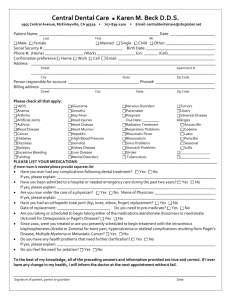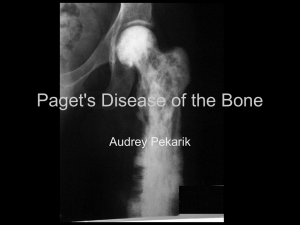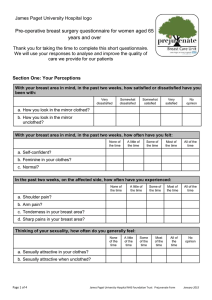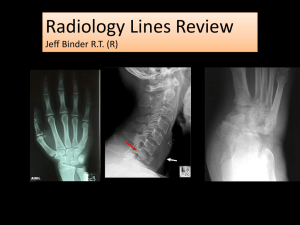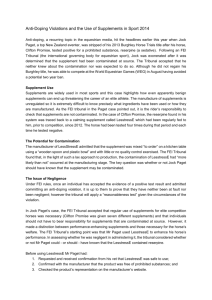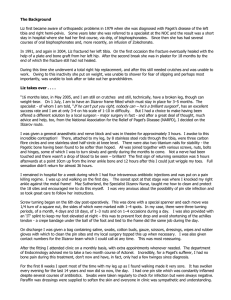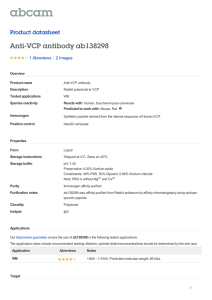Department of Medical History Sir James Paget’s research into medical education
advertisement
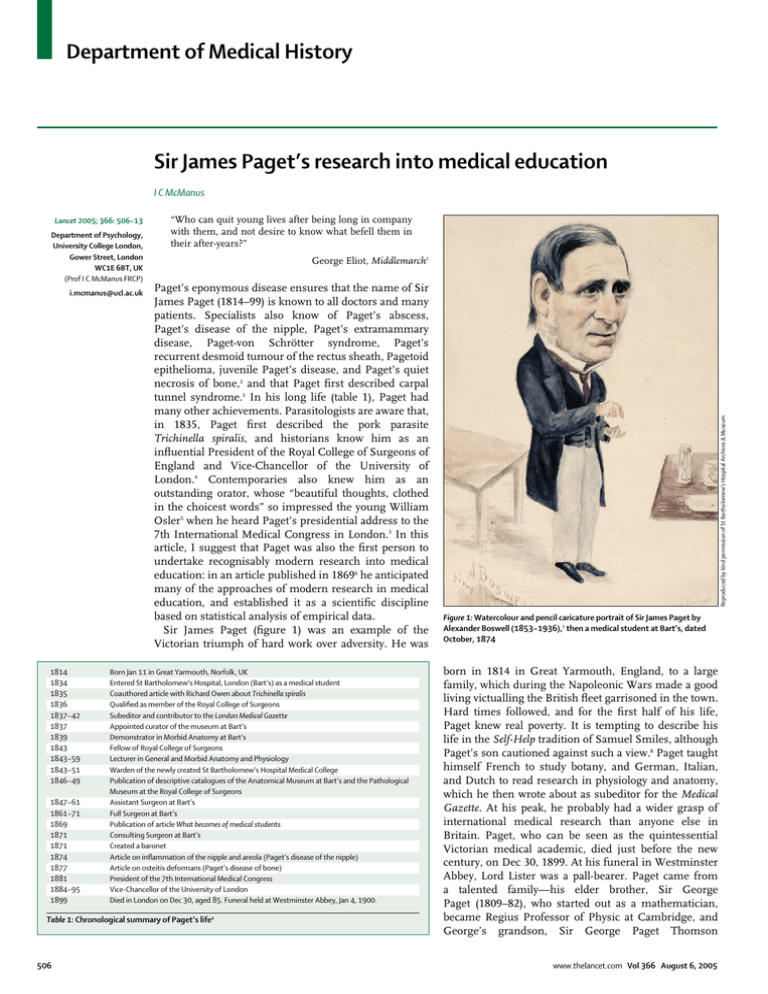
Department of Medical History Sir James Paget’s research into medical education I C McManus i.mcmanus@ucl.ac.uk 1814 1834 1835 1836 1837–42 1837 1839 1843 1843–59 1843–51 1846–49 1847–61 1861–71 1869 1871 1871 1874 1877 1881 1884–95 1899 “Who can quit young lives after being long in company with them, and not desire to know what befell them in their after-years?” George Eliot, Middlemarch1 Paget’s eponymous disease ensures that the name of Sir James Paget (1814–99) is known to all doctors and many patients. Specialists also know of Paget’s abscess, Paget’s disease of the nipple, Paget’s extramammary disease, Paget-von Schrötter syndrome, Paget’s recurrent desmoid tumour of the rectus sheath, Pagetoid epithelioma, juvenile Paget’s disease, and Paget’s quiet necrosis of bone,2 and that Paget first described carpal tunnel syndrome.3 In his long life (table 1), Paget had many other achievements. Parasitologists are aware that, in 1835, Paget first described the pork parasite Trichinella spiralis, and historians know him as an influential President of the Royal College of Surgeons of England and Vice-Chancellor of the University of London.4 Contemporaries also knew him as an outstanding orator, whose “beautiful thoughts, clothed in the choicest words” so impressed the young William Osler5 when he heard Paget’s presidential address to the 7th International Medical Congress in London.3 In this article, I suggest that Paget was also the first person to undertake recognisably modern research into medical education: in an article published in 18696 he anticipated many of the approaches of modern research in medical education, and established it as a scientific discipline based on statistical analysis of empirical data. Sir James Paget (figure 1) was an example of the Victorian triumph of hard work over adversity. He was Born Jan 11 in Great Yarmouth, Norfolk, UK Entered St Bartholomew’s Hospital, London (Bart’s) as a medical student Coauthored article with Richard Owen about Trichinella spiralis Qualified as member of the Royal College of Surgeons Subeditor and contributor to the London Medical Gazette Appointed curator of the museum at Bart’s Demonstrator in Morbid Anatomy at Bart’s Fellow of Royal College of Surgeons Lecturer in General and Morbid Anatomy and Physiology Warden of the newly created St Bartholomew’s Hospital Medical College Publication of descriptive catalogues of the Anatomical Museum at Bart’s and the Pathological Museum at the Royal College of Surgeons Assistant Surgeon at Bart’s Full Surgeon at Bart’s Publication of article What becomes of medical students Consulting Surgeon at Bart’s Created a baronet Article on inflammation of the nipple and areola (Paget’s disease of the nipple) Article on osteitis deformans (Paget’s disease of bone) President of the 7th International Medical Congress Vice-Chancellor of the University of London Died in London on Dec 30, aged 85. Funeral held at Westminster Abbey, Jan 4, 1900. Table 1: Chronological summary of Paget’s life4 506 Reproduced by kind permission of St Bartholomew’s Hospital Archives & Museum Lancet 2005; 366: 506–13 Department of Psychology, University College London, Gower Street, London WC1E 6BT, UK (Prof I C McManus FRCP) Figure 1: Watercolour and pencil caricature portrait of Sir James Paget by Alexander Boswell (1853–1936),7 then a medical student at Bart’s, dated October, 1874 born in 1814 in Great Yarmouth, England, to a large family, which during the Napoleonic Wars made a good living victualling the British fleet garrisoned in the town. Hard times followed, and for the first half of his life, Paget knew real poverty. It is tempting to describe his life in the Self-Help tradition of Samuel Smiles, although Paget’s son cautioned against such a view.8 Paget taught himself French to study botany, and German, Italian, and Dutch to read research in physiology and anatomy, which he then wrote about as subeditor for the Medical Gazette. At his peak, he probably had a wider grasp of international medical research than anyone else in Britain. Paget, who can be seen as the quintessential Victorian medical academic, died just before the new century, on Dec 30, 1899. At his funeral in Westminster Abbey, Lord Lister was a pall-bearer. Paget came from a talented family—his elder brother, Sir George Paget (1809–82), who started out as a mathematician, became Regius Professor of Physic at Cambridge, and George’s grandson, Sir George Paget Thomson www.thelancet.com Vol 366 August 6, 2005 Department of Medical History (1892–1975), was the recipient of the 1937 Nobel Prize in Physics. Paget’s 1869 article Reproduced by kind permission of St Bartholomew’s Hospital Archives & Museum Paget’s article of 18696 provides what is probably the first formal approach to assessing the outcome of medical education. Immediately after it was published in the St Bartholomew’s Hospital Reports, a notice in The Lancet described it as “brief and brilliant”.9 Sir Francis Galton later found it “singularly interesting”, pointing out that it “did for St. Bartholomew’s Hospital what has never yet been done, as far as I am aware, for any University or Public School, whose historians count the successes and are silent as to the failures, giving to inquirers no adequate data for ascertaining the real value of those institutions in English Education”;10 and a 1948 article in The Lancet added, “Eighty years after Paget wrote, the case is little better . . .”.11 The 1869 article starts with an anecdote about John Abernethy (1764–1831), the surgeon and teacher at Bart’s, whom Paget would not have met but whom he later said should be remembered “not as a rough wit or a mere eccentric, but as a man of rare sagacity, an admirable surgeon and teacher, and one of the most graceful scientific writers of his time” (p 375).8 When Reproduced by kind permission of St Bartholomew’s Hospital Archives & Museum Figure 3: Watercolour and pencil caricature portrait of Sir Thomas Smith by Alexander Boswell, dated 1875 Figure 2: Watercolour and pencil caricature portrait of George William Callender by Alexander Boswell, dated October, 1874 www.thelancet.com Vol 366 August 6, 2005 entering a lecture theatre at the beginning of a session, Abernethy reportedly said, “Good God! What will become of you?” (p 238).6 It was that fundamental question which Paget set out to answer, as he later put it, “in the dullest way—by statistics”.8 Although the 1869 article is in Paget’s name alone, he makes clear that “Mr Callender” and “Mr Smith”, were closely involved and that they “worked together for this essay” (p 239).6 Brief accounts of the distinguished careers of George Callender (figure 2) and Sir Thomas Smith (figure 3) are shown in panel 1. Paget’s son, the surgeon Stephen Paget, later described how, “The essay is only five pages long: but it was very hard work for him and his colleagues” (p 244).8 In 1839, Paget had eventually been appointed to St Bartholomew’s Hospital after a slow and frustrating start to his career. As well as being Warden of the College, he was also a dedicated teacher, appreciated by students such as Hughlings Jackson, who “was deeply impressed by Sir James Paget, who became a friend for life”.19 From 1839 to 1843, Paget demonstrated in Morbid Anatomy, and then from 1843 to 1859 lectured on General and Morbid Anatomy, and Physiology. The 1869 article states that an entry-book contained the names of the 1226 students registering for courses between 1839 and 1859 (although my reading finds 1325 names). Paget, 507 Department of Medical History Panel 1: Paget’s collaborators George William Callender (1830–78). Entered Bart’s in 1849, becoming Dresser, Clinical Clerk, House Surgeon, until eventually, in 1871, he was appointed Surgeon, and Professor of Anatomy at the Royal College of Surgeons. He was “noted for neatness and accuracy, pleasing manners, and a well-dressed appearance”,12 and as a surgeon was “dextrous and neat”.13 Elected FRS in 1871 for his work on the development of the bones of the face. As well as articles on hernia, diseases of veins, fracture of the patella, mortality after amputation, and brain damage, he wrote a rather conservative essay entitled On the present system of medical education in England,14 which began, “It is my opinion that little, if any, change in the existing regulation is at present desirable”. He was, nonetheless, one of few staff at Bart’s who was sympathetic to female medical students.15 He suffered from Bright’s disease, and died at sea, on Oct 20, 1878, while returning from a journey to the USA.16 Sir Thomas Smith (1833–1909). Entered Bart’s in 1849. Described as “being like a son” to Paget,8 whom he helped in his private practice, while himself living in near poverty. Appointed Assistant Surgeon to the Great Ormond Street Children’s Hospital, London, in 1861, and Surgeon in 1868.17 His operation for lateral lithotomy in children established his reputation for technique, and he later developed operations for hare lip, cleft palate, tracheostomy, plastic surgery, and urethral surgery. Unlike Callender, he was an early proponent of antiseptic surgery,18 and a medical student’s “Antiseptic Ode”, dedicated to Smith, began, “Acid to right of them / Acid to Left of them / Acid in front of them / Squirted and swamped them [the bacteria]”.15 In 1873, he first used the technique of transfusing defibrinated blood into a neonate. A deeply religious man, he declined the Presidency of the College of Surgeons after his wife’s death during the birth of their ninth child, and devoted himself instead to bringing up their family. Made a baronet in 1899 during Queen Victoria’s jubilee celebrations.18 Callender, and Smith could not trace all the students, and the article describes the outcome of the conveniently round number of 1000 students whose careers they knew some 10 to 30 years later. A striking feature of the study is the use of what would now be described as behavioural anchors for categorisation of career outcomes (table 2), an approach no doubt derived from Paget’s philosophy for cataloguing of the pathological collections of Bart’s and the College of Surgeons, that “nothing was to be told but what was there and could be seen” (p 85).8 The same classification was subsequently used somewhat less successfully for studies at St George’s20,21 and St Thomas’s Hospitals.22 Paget measured a moderately high dropout rate during training of about 10%, which is not dissimilar from estimates from the end of World War I23 or modern studies.24,25 By contrast, there was the “melancholy list of deaths”, for “nearly 13 per cent were dead within fifteen years” (p 241).6 Death in training and practice, which is now rare and was already declining by the 1880s,20 might seem to reflect the dangers of Victorian medicine (indeed, in 1871, Paget himself nearly succumbed to a post-mortem acquired septicaemia26). However, Paget rejected that explanation, because “according to the ‘English Life Table No. 3’ out of any 1,000 males who have attained the age of 19 years 131 will die within 15 years”(p 241);6 hence "it gives no reason for considering the medical profession either less or more healthy than other pursuits, at least in its earlier stages”(p 241).6 Number of students Paget’s description Distinguished success 23 Great success 66 Fair or moderate success 507 Very limited success 124 Failed entirely 56 Left the profession 96 “Within fifteen years after entering, gained, and to the end of the time maintained, leading practices in counties or very large towns, or held important public offices, or became medical officers of large hospitals, or teachers in great schools, as the Professors of Anatomy in Oxford, Cambridge, and Edinburgh, all of whom it was my singular good fortune to have for pupils” “gained and still hold high positions in the public services, or leading practices in good districts, or who retired with money earned in practice, or gained much more than ordinary esteem and influence in society” “that measure of well-doing which consisted in having a fair practice—enough to live with—maintaining a good professional and personal reputation, or in holding ordinary appointments in the public services, or in the colonies, and gaining promotion in due course of time” “those who, within the fifteen years, were not even in moderately good practice, or apparently likely to attain it; or who were just living, and that not well, by their work; or still employed as assistants in ordinary practices, or erratic and never prosperous; or doing much less than, with their education and other opportunities of success, they should have achieved” “a very mixed class, agreeing only in their total want of success. Of the 56 who made up the total, 15 were never able to pass examinations—some because of idleness or listlessness, a very few through sheer want of intellect. Of those who did pass, 6 failed because of scandalous misconduct; 10 through ill-health or misadventure, sheer ill-luck as it seemed; and 10 through their continuance in the same habits of intemperance or dissipation as had made us, even while they were students, anticipate their failure. Of the remaining 16 we know only that they have failed; they are not in disrepute, but they are barely maintaining themselves” “13 while pupils left or were expelled in disgrace, and 3 were wisely removed by their friends.” Of the remainder, two “retired on private means, too rich to need to work”, four left in disgrace after qualifying, three became actors, four entered the army with commissions and three as privates, one entered the Bar, five took Orders in the Church of England and two in the Church of Rome, ten entered business, and “3 became homoeopathic practitioners, but took to that class no repute for either wisdom or working power” “21 died of diseases incurred in their duties; 5 of them committed suicide, 2 of them under circumstances of great disgrace; 1 was hung.” “17 who died of phthisis, 4 (at least) of fever caught in the Hospital, and 2 who committed suicide” Died within twelve years of 87 commencing practice Died during pupillage 41 Table 2: Paget’s outcome categories 508 www.thelancet.com Vol 366 August 6, 2005 Department of Medical History Paget’s own career Reproduced by kind permission of the President and Council of the Royal College of Surgeons of England Although later in his own life, Paget’s career was clearly extremely successful, how might his career be judged against his own criteria, assessing his achievements 15 years after medical school entry? Paget entered Bart’s as a student in 1834, and by 1849, at the age of 35, he had undoubtedly achieved “Distinguished success”, being appointed Professor of Anatomy and Surgery at the College of Surgeons in 1847. As a surgeon, though, he had yet to undertake any major operation, and his academic successes were far from matched by financial success, or even financial security, and he later commented, “if I had died before I was 47 [in 1861], I should have left my wife and children in extreme poverty” (p 193).8 The entry-book Palmer’s execution, although Paget may have been long aware of Palmer’s personality and habits. No precise dating is available for Paget’s comments. However, his not entirely flattering comments on George Callender, his eventual collaborator (“moderately good thinker”) suggest that Paget originally intended to do all the work himself. Several comments refer specifically to 1860 or 1861 (“Went into the Army and in 1860 was in the 54th”), making that the time when Paget most probably wrote or added to his comments, soon after leaving Bart’s. In my opinion, the project was probably put to one side as Paget’s private practice became busier, only to be finished with the 100 160 90 140 80 120 70 100 60 50 80 % “It contains many pleasant prophecies, that have long been fulfilled, and one or two very gloomy verdicts: for instance, he has written opposite the name of the one student who was at last hanged for murder—‘Idle, dissolute, extravagant, vulgar, and stupid. He scarcely ever practised, and was chiefly engaged in the turf’” (p 185).8 Figure 4: A page from Paget’s entry-book The detail shows the signature of George Callender, Paget’s future collaborator on the 1869 article. Number of students Paget’s entry-book (figure 4) is preserved in the library of the Royal College of Surgeons of England in London, and a transcript is available.27,28 The original register was written in a small notebook with very pale green pages, 160 mm wide by 188 mm high, ruled with 20 faint blue lines on each page. Subsequently other ruled pages, of a medium blue, were interleaved, and the book rebound. Each entrant signed their name and Paget recorded how much they had paid and for how many sessions. Later, each student was numbered. The interleaved pages give brief descriptions of 386 (29%) of the 1325 entrants, usually in Paget’s writing. Paget knew many students well, for “he dined every day in Hall with twenty or more students” (p 127).8 The other students were, presumably, known to Callender or Smith, a “popular and risqué lecturer”15 who probably knew his students well. The dates when the comments were written by Paget are unclear. His son and biographer, Stephen, implies that some comments were properly prospective when he says that Paget “used to write short notes in [the entrybook], how the men had fared at the Hospital, and afterward in practice”: 40 60 30 Stephen Paget’s description of “prophecies” is only partly correct. The reference is to Dr William Palmer (1824–56), the Rugeley Murderer, one of a litany of doctors who have poisoned their patients29 (although the case has its controversies, and the novelist Robert Graves maintained there was a miscarriage of justice30). Paget’s comments on Palmer actually continue, apparently in the same writing and the same ink, “He was hung for the murder of a friend Wm. Cook in [blank]”. The entire comment was probably written after www.thelancet.com Vol 366 August 6, 2005 40 20 20 0 10 3 5 6 1 9 4 7 2 8 3 4 5 6 9 7 8 –4 3– 4– 5– 6– 7– 8– 0– 1– 2– 3– 4– 5– 6– 7– 8– 39 184 184 184 184 184 184 185 185 185 185 185 185 185 185 185 8 1 Year 0 Figure 5: Paget’s students Bars=number of students entering Paget’s demonstrations (1839–43) and lecture courses (1843–59). ●=percentage of students in entry-book on whom Paget made comments. 509 Department of Medical History assistance of his collaborators. Proportionately more of Paget’s comments refer to students entering Bart’s in the earlier rather than later part of his lectureship (figure 5), those students presumably being the ones whose careers he knew best, with the later entrants being better known to Callender and Smith. There is therefore the possibility of confounding or bias in Paget’s comments. Paget’s comments, which Peterson31 emphasises are “the only systematic observation of London medical students in the Victorian period uncovered to date”, not only indicate Paget’s intense interest in teaching and his students, but are also rich, varied, witty, and sometimes filled with pathos, providing a panoply of the highlights and lowlife of Victorian medicine. Paget was well placed to make such observations, for “being always in the hospital he soon knew everybody” (p 125).8 Panel 2 lists some examples, including one of the first women doctors—Elizabeth Blackwell—who attended Paget’s lectures, having already graduated from Geneva College in New York (and in a letter, Paget’s mother described Panel 2: Examples of comments made by Paget in his entry-book Jonathan Hutchinson (517): “One of the most industrious observers of cases that I ever knew. I recommended him for the work of reporting for the Medical Gazette, & he did excellently in it & rose well” (For his career see Herbert Hutchinson’s Life32) Dr Elizabeth Blackwell (521): “The celebrated Dr. Elizabeth Blackwell—a sensible, quiet, discreet lady,—she gained a fair knowledge (not more) of medicine; practised in New York; then tried to promote female doctordom in England” E L LaFargue (668): “Loitered about as a student; & being rather pretty & having a little money, he left in 1854–55 & slowly qualified for the Army. Was to have his commission in 1860, but he joined Garibaldi” Clement John Carnell (710): “Stupid, dissolute, drunken. After he passed, a woman whom he lived with being pregnant, he killed her by the ignorant way in which he tried to produce abortion & he then committed suicide. He was much under the guidance of Sievier—Aug ‘59” James Richard Hancorn (791): “Idle, dissipated, drinking,—associate of Sievier. Had to resign the House Surgeoncy; practised a few months with his father in Shoreditch; & died in 1860” Tom Oliver Hunt (751) “Good tempered, easy, rather careless. Was an assistant variously; but in 1861 was drinking hard & fast losing way” F W Brown (1078): “Idle and dissipated, but pulled up in time & was in fair prospects at Uppingham in 1864” George Taylor (116): “Unteachably dull, though willing & with no vice. He could get no diploma, but went to be an assistant to his brother in Essex & was ‘very well liked’” Joseph Eld (54): “One of the most laborious, clear-headed, and capacious students I ever knew. He could learn everything without a fault. Besides, he was eminently industrious & gentle. So beautiful a mind, surely never occupied so grotesque & strange a body: and this inferior part of him died after his 2nd year of study”. Numbers in brackets are those assigned to the students in the entry-book. 510 how “our ‘Lady Doctor’” had “tak[en] her seat with perfect composure”8 at Paget’s lectures [p 168]). These cameos could form the basis of a more systematic reconstruction of mid-Victorian medical practice. Panel 3 shows some additional details I could find when tracing two randomly chosen examples of Paget’s early pupils, purely as a pilot or proof of principle. Unfortunately the entry-book does not contain the coded outcome categories used by Paget, Smith, and Callender, and therefore it is not possible without much further work to do any formal correlation of outcome with Paget’s comments. The analysis of the entry-book was not Paget’s only empirical research in medical education. He was instrumental in setting up the residential college at Bart’s, a model soon copied by other schools,35 as a solution to the disciplinary problems “‘of low men, of low habits’ who appalled urban society”.36 The college was at first opposed by the profession; The Lancet described it as a “Medical Nursery”, where “twenty cots have been got ready for tucking in young gentleman at night”.37 Paget nevertheless believed that residence was beneficial, and in the session of 1849–50 he reported that although only 32 men were resident in the college—a fifth of the whole school—“they had carried off half the Hospital prizes” (p 168).8 If there were 20 prizes in total (and in 1847 there were 27 prizes and 20 prize winners),38 this proportion would represent an odds ratio of about 5·4—a substantial effect size. Although the study could not meet 21st-century standards of either random allocation or adequate measurement of baseline differences in the groups, it does clearly show the principle that measurement can illuminate and resolve such questions, and Paget was far ahead of his time in so doing. “Idle, dissolute” The comments on William Palmer include the interesting phrase “idle, dissolute”. Of the 386 comments made by Paget, 52 (13%) contain the word idle (or sometimes the phrase half idle), and four (1%) include dissolute, in all but one case paired with idle. Variations on this phrase recur in Paget’s other writings. In his memoirs,8 some of the hospital apprentices are referred to as “idle men” (p 84), and among the first residents of the College at Bart’s were “a few idle, dissolute fellows whom I had to get rid of by persuasion or compulsion”(p 129). Another student is described as among “the most thoroughly idle gentlemanly students that I have ever known” (p 149).8 Paget described how, in 1843, the Medical College at St Bartholomew’s was introduced, in part as a response to a case in which “the son of an old pupil who was intimate with several of the staff had spent his whole time in dissipation, and gone utterly to the bad” (p 122). The college meant that “it was no longer possible for any one to be thoroughly idle . . . without being observed” (p 125),8 and Paget advocated www.thelancet.com Vol 366 August 6, 2005 Department of Medical History the collegiate system as “of great value in preventing the idle from becoming dissolute” (p 152). Perhaps the most striking use of the phrase is in the opening pages of Paget’s memoirs.8 Paget describes his mother as “never idle” (p 8), and his father, Samuel Paget, as an “active” man (p 2), “busy all day” (p 3). He then describes his father’s father, whom, “I have heard, was an idle and rather dissolute man, from whom [Samuel Paget] derived no money or help in either teaching or example”.8 Paget himself was famously busy, his son describing “his love of hard work”, and Charles Darwin, who corresponded with him for many years, saying in a letter of 1880, “What indomitable activity you have!”(p 309).8 Paget attributed his own successful career to his not being, “disqualified by any of the gravest hindrances to success: as by being habitually idle, time-wasting, unbusinesslike, unpunctual, uncivil, unable to work with others; faults which I have seen singly or together spoiling the careers of men whose knowledge might have brought them great success”(p 189).8 Paget’s aphorisms describe work as its own reward: “No man ever did good work who was not frequently over-worked” (p 405); “The reward of work is better and higher-paid work”(p 445).8 Such views originated in a strong sense of public duty, and a strong religious faith, with “the habit of reverence, and the habit of devotion” (p 428).8 In his twenties, stimulated by an admiration of John Keble and the Oxford movement, Paget had demonstrated an unostentatious religious asceticism, such that “[out of ] some measure of respect for the discipline of fasting, which was then being revived among Churchmen, I went without dinner on Fridays” (p 77).8 Even late in life, Paget, who by then was one of the richest doctors in England, would talk of how “Comfortable idleness . . . is a despicable result of good health”, and how instead the truly healthy man “does the largest amount of the best work that he can”.39 Paget the psychologist Paget gained his early academic reputation as an indexer and cataloguer of the pathological collections of St Bartholomew’s Hospital and the College of Surgeons, and his study of medical students can be seen as another example of his “love of index-making” (p 84).8 From this discipline to his psychological and sociological work on medical education might seem a long journey for a pathologist and a surgeon, although the 1869 article is indeed a catalogue, albeit of souls rather than specimens, but still seemingly the stolid but invaluable work of a harmless drudge. However, later in life, he described pathology itself in far broader terms: www.thelancet.com Vol 366 August 6, 2005 Panel 3: Follow-up of two randomly chosen doctors described by Paget John Samuel Beale. Described by Paget as “Commonplace, vulgar, shrewd. Practising in Paddington actively in 1860 and often writing on Obstetrics”. Qualified MRCS 1846, LM 1853. He published several times in The Lancet from 1846 to 1864, as well as in the Medical Times. By the 1875 Medical Directory, he was described as Fellow of the Obstetrical Society of London, and “Surgeon to HRH the Nawab Nizam of Bengal, Behar and Orissa, and Suite, and to his Excellency Hafiz Ahmed Hassam Khân Bahadoor”. He died in 1875. Although no obituary could be found in the BMJ or The Lancet, a letter did appear in The Lancet on Jan 1, 1876: “An appeal. In consequence of the death of the late Mr John Samuel Beale, MRCS, who practised as a surgeon at Paddington for nearly thirty years, his widow has been left without any means for her future support . . .”, and asking for subscriptions. In the Jan 29 issue of The Lancet, his widow, Sarah, names ten individuals who had thus far donated at total of 15 guineas, including 2 guineas from Sir James Paget. However, by March 18, a further note gives the names of another ten donors, including Sir Thomas Watson, sometime President of the Royal College of Physicians, who subscribed a further £18/10/0. However, “I beg to inform you the amount received is not sufficient to enable me to proceed to Canada . . .” No further correspondence was published, and it is not clear whether Mrs Beale ever reached Canada. Perhaps Beale was not as shrewd in financial matters as Paget had suspected. James Yates. Described by Paget as “The most simple, and witless man of the year,—the butt of the college—a very muff; but he worked hard, and went to practice in Newcastle (Staffordshire) and did as much as he had wits for”. He qualified MRCS Eng & LSA in 1846, and first appears in the Medical Directory of 1851, where he subsequently describes himself as “Medical Officer, Newcastle-under-Lyme Workhouse and District”. He briefly appears in The Lancet in 1860, as Honorary Secretary of the North Staffordshire Medical Registration Association, protesting against some of the responses of the Royal College of Surgeons to Medical Registration.33 In 1869, he was treasurer of the North Staffordshire Medical Society.34 His directory entry remains unchanged until 1892, when he retired to Perry Barr, Birmingham, and then to the Huntingdon Road in Cambridge. His last appearance in the Medical Register is in 1909, and he presumably died that year. No obituary could be found. There is no evidence of local opinion of his career as medical officer at the workhouse. I suspect, though, that he might have been respected and admired more than he was at Bart’s, and that hard work indeed overcame many obstacles. Or perhaps, as George Eliot puts it in Middlemarch, there is a general perception that “everybody’s family doctor was remarkably clever, and was understood to have immeasurable skill in the management and training of the most skittish or vicious diseases”. “now there is work in it not only for the anatomist and physiologist, but for the clinical observer, the experimentalist, the minutest microscopist, the statistician, the chemist, the naturalist, the historian, the psychologist, and yet more” (p 370).8 Paget’s political work in late life on university, college, and government committees, suggests an acceptance of the dictum of the great pathologist Rudolf Virchow, whom Paget knew and admired, that “Medicine is a social science, and politics is nothing but medicine on a grand scale”.40 George Eliot commented in Middlemarch that, “a medical man likes to make psychological observations” (p 321),1 and that was certainly true of Paget, who ends his 1869 article by saying, “in watching and reflecting on 511 Department of Medical History the careers of my pupils, I have come to some strong beliefs on medical education”: “the personal character, the very nature, the will, of each student had far greater force in determining his career than any helps or hindrances whatever . . . The time and the place, the work to be done, and its responsibilities, will change; but the man will be the same, except in so far as he may change himself” (p 242).8 Elsewhere he put it more pithily: “Such as the student had been, such was the practitioner” (p 375), although he admits, “There were some few exceptions”.8 Concerning the nature of scientific study, he asked “What is to be the force? What to be the driving force?”, and concludes “It must be each man’s will, by whatever motive stirred; when the will is wanting, the most perfect scheme is useless” (p 375).8 And the will becomes more important with increasing age, “for at last will becomes habit, as certainly for mental as it does for muscular uses” (p 375).8 In 1873, at a dinner at the Philosophical (Society), Sir Francis Galton told Paget of his work on the nature of scientific men, and of his surprise at “their very high average of energy and capacity in mere business; the last thing the ‘vulgar’ would expect of those whom they scoff at as mere philosophers” (p 271).8 Paget, though, was not surprised: “the energy is usually the fact, the scientific pursuit the accident, of the successful career” (p 271).8 The will, energy, and drive made for success: “If a man of science cannot be business-like, it is the fault of his brain, not of his study; he would have been the same in any other pursuit in life” (p 374).8 Paget, like Galton, interpreted his findings mainly in terms of inborn propensities of character, and of energy and will—of personality and motivation in modern terminology (and Paget’s view is largely consistent with our own work relating medical student personality, study habits, and motivation to career fulfilment and success41). Paget—the founder of empirical research in medical education? Paget was far ahead of his time in his approach to medical education. His 1869 article, which medical educationalists have almost entirely neglected (the article has not been cited in any medical education journal since 1981), introduced many of the approaches that underpin the foundations of the empirical study of medical education as a scientific discipline. Just as John Graunt’s 1662 analysis of bills of mortality presaged modern epidemiology,42 or John Snow’s study of the Broad Street pump initiated modern public health research,43 so Paget’s article initiated research in medical education, and, despite being neglected, anticipated much that eventually followed. An appropriate historical parallel 512 might be the work of Gregor Mendel, whose novel ideas in his almost exactly contemporary article of 1866 were unjustly neglected for decades.44 In 1969, exactly a century after Paget had published his article, the medical educationalist George Miller wrote that “interested individuals have been thinking and writing for centuries about the means of preparing physicians”,45 referring no doubt to those such as Hodkgin,46 Billroth,47 Osler,48 and Flexner.49 But Miller then wrote, “the study of medical education is a new order of things” (emphasis in original),45 a point echoed by Simpson,50 and seemingly confirmed by histories of medical education that do not even discuss educational research.51,52 A glance at the published work might suggest that the empirical study of medical education developed only at the end of World War II (for instance studies in the British Medical Journal in 194653 and The Lancet in 194854), or even a decade later.55,56 Indeed, an obituary of Miller claimed that in 1955 he changed career “ . . . to enter a new and wholly undeveloped hybrid medical specialty—Research in Medical Education of which he was the primary founder”57 (my emphasis). However, nearly a century earlier, Paget was already working on the 1869 article whose unique achievement which singularly anticipated the questions, the methods, and the approaches of future empirical research in medical education, and which deserves proper recognition. Conflict of interest statement I declare that I have no conflict of interest. Acknowledgments I am grateful to Tina Craig, and the staff of the Library of the Royal College of Surgeons of England, to Samantha Farhall and Katie Ormerod of the St Bartholomew’s Hospital Archives, and to Stella Butler for their assistance, and to four anonymous referees for their comments. References 1 Eliot G. Middlemarch (first published 1871–72). Harmondsworth: Penguin, 1965. 2 Shaw AB. Paget’s diseases. Practitioner 1980; 224: 1323–27. 3 Paroski MW, Fine EJ. Sir James Paget and the carpal tunnel syndrome. Neurology 1985; 35: 448. 4 Peterson MJ. Paget, Sir James, first baronet (1814–1899). www.oxforddnb.com/view/article/21113 (accessed Oct 4, 2004). 5 Bliss M. William Osler: a life in medicine. Oxford: Oxford University Press; 1999. 6 Paget J. What becomes of medical students. Saint Bartholomew’s Hospital Reports 1869; 5: 238–42. 7 Anonymous. Derby Evening Telegraph (Derby), Nov 6, 2003. 8 Paget J. Memoirs and letters of Sir James Paget, 3rd edn (Paget S, ed). London: Longmans, Green and Co, 1903. 9 Anonymous. What becomes of medical students? Lancet 1869; 2: 653–54. 10 Galton F. Natural inheritance. London: Macmillan, 1889. 11 Harris AD. The selection of medical students. Lancet 1948; 2: 317–21. 12 Dobson J. Pioneers of osteogeny: George William Callender. J Bone Joint Surg 1949; 31: 127–29. 13 White H. Surgery in the eighteenth and nineteenth centuries. In: Medvei VC, Thornton JL, eds. The Royal Hospital of Saint Bartholomew 1123–1973. London: St Bartholomew’s Hospital, 1974: 205–21. www.thelancet.com Vol 366 August 6, 2005 Department of Medical History 14 15 16 17 18 19 20 21 22 23 24 25 26 27 28 29 30 31 32 33 34 35 Callender GW. On the present system of medical education in England. London: Spottiswoode, 1864. Waddington K. Medical education at St. Bartholomew’s Hospital 1123–1995. Woodbridge, Suffolk: Boydell Press, 2003. Paget J. Obituary: George William Callender. Saint Bartholomew’s Hospital Reports 1879; 15: 41–47. Power D, rev Reznick JS. Smith, Sir Thomas, first baronet (1833–1909). http://www.oxforddnb.com/view/article/36161 (accessed April 5, 2005). Various authors. Obituary: Sir Thomas Smith. BMJ 1909; 2: 1101–04. Critchley M, Critchley EA. John Hughlings Jackson: Father of English neurology. Oxford: Oxford University Press, 1998. Anonymous. Medicine, its practice and its public relations (Part III). Lancet 1905; 1: 593–95. Corner EM. What becomes of medical students. Lancet 1929; 2: 951. Corner EM. The careers of ten years of students entering St. Thomas’s Hospital. St Thomas’s Hospital Gazette 1920; 27: 288–90. Little EG. The health and conditions of work of medical students. Lancet 1929; 2: 907–10. McManus IC. Drop out rate in medical schools seems reasonable. BMJ 1996; 313: 173. Arulampalam W, Naylor R, Smith J. Factors affecting the probability of first-year medical student dropout in the UK: a logistic analysis for the intake cohorts of 1980–1992. Med Educ 2004; 38: 492–503. Paget J. Notes for a clinical lecture on dissection poisons. Lancet 1871; 1: 735—36, 774–76. Thornton JL. Medical students at St Bartholomew’s Hospital Medical School who attended Paget’s demonstrations and lectures, 1839–1859. London: Library of the Royal College of Surgeons of England (bound typescript), 1957. Thornton JL. Sir James Paget’s notes on his students. Ann R Coll Surg 1957; 21: 199–201. Kinnell HG. Serial homicide by doctors: Shipman in perspective. BMJ 2000; 321: 1594–97. Graves R. They hanged my saintly Billy: the life and death of Dr William Palmer. London: House of Stratus, 1957. Peterson MJ. Gentlemen and medical men: the problem of professional recruitment. Bull Hist Med 1984; 58: 457–73. Hutchinson H. The life and letters of Jonathan Hutchinson. London: Heinemann, 1946. Turner SM, Yates J. The College of Surgeons and uneducated candidates. Lancet 1860; i: 382–83. Anonymous. North Staffordshire Medical Society. Medical Times and Gazette 1869; 2: 645. Bonner TN. Becoming a physician: Medical education in Great www.thelancet.com Vol 366 August 6, 2005 36 37 38 39 40 41 42 43 44 45 46 47 48 49 50 51 52 53 54 55 56 57 Britain, France, Germany, and the United States, 1750–1845. New York: Oxford University Press, 1995. Waddington K. Mayhem and medical students: image, conduct, and control in the Victorian and Edwardian London teaching hospital. Soc Hist Med 2002; 15: 45–64. Anonymous. Medical Nursery. Lancet 1843; 40: 487. Anonymous. St Bartholomew’s Hospital and Medical College. The Times (London), May 12, 1847: 7. Paget J. National Health and National Work [1884]. In: Paget S, ed. Selected essays and addresses by Sir James Paget. London: Longmans, Green & Co, 1902: 381–97. Bauer AW. “Die Medicin is eine sociale Wissenschaft”: Rudolf Virchow (1821–1902) als Pathologe, Politiker und Publizist. Med Bibl Inf 2005; 5: 16–20. McManus IC, Keeling A, Paice E. Stress, burnout and doctors’ attitudes to work are determined by personality and learning style: a twelve year longitudinal study of UK medical graduates. BMC Med 2004; 2: 29. Rothman KJ. Lessons from John Graunt. Lancet 1996; 347: 37–39. Brody H, Rip MR, Vinten-Johansen P, Paneth N, Rachman S. Mapmaking and myth-making in Broad Street: the London cholera epidemic, 1854. Lancet 2000; 356: 64–68. Mendel G. Versuche über Pflanzen-Hybriden. Verh Naturforsch Ver Brünn 1866; 4: 3–47. Miller GE. The study of medical education. Br J Med Educ 1969; 1: 3–5. Hodgkin T. An essay on medical education. London: W Phillips, 1828. Welch WH. The medical sciences in the German universities: a study in the history of civilization. New York: Macmillan, 1924. Osler W. Aequanimitas (3rd edn). London: H K Lewis, 1932. Flexner A. Medical education: a comparative study. New York: MacMillan, 1925. Simpson MA. Medical education: a critical approach. London: Butterworths, 1972. Nutton V, Porter R, eds. The history of medical education in Britain. Amsterdam: Editions Rodopi, 1995. O’Malley CD, ed. The history of medical education. Berkeley, CA: University of California Press, 1970. Selection of medical students. BMJ 1946; 2: 375–76. Selected seed. Lancet 1948; 2: 333–34. Merton RK, Reader GG, Kendall PL. The student physician. Cambridge, MA: Harvard University Press, 1957. Becker HS, Geer B, Hughes EC, Strauss AC. Boys in white: student culture in medical school. Chicago: University of Chicago Press; 1961. McGuire C. George E Miller, MD, 1919-98. Med Educ 1999; 33: 312–14. 513
